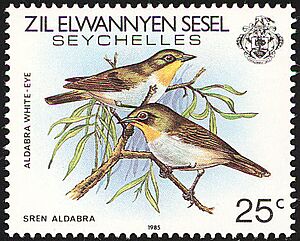Seychelles white-eye facts for kids
Quick facts for kids Seychelles white-eye |
|
|---|---|
 |
|
| Seychelles white-eye | |
| Conservation status | |
| Scientific classification | |
| Genus: |
Zosterops
|
| Species: |
modestus
|
The Seychelles white-eye (Zosterops modestus) is a rare bird that looks a bit like a warbler. It belongs to the white-eye family. This special bird lives only in the Seychelles islands. For a while, people thought it had disappeared completely. But then it was found again! Now, it is listed as a Vulnerable animal by a group called the IUCN. This means it needs protection to survive.
What Does the Seychelles White-Eye Look Like?
This bird is about 10 to 11 centimeters (4 to 4.3 inches) long. Its upper feathers are a mix of olive and grey. The feathers underneath are a duller color. A thin, white ring around its eye gives it its name. It also has a fairly long, dark-grey tail and a small, sharp beak.
What Does This Bird Eat?
The Seychelles white-eye enjoys eating different kinds of insects. These include insect larvae, locusts, and grasshoppers. It also likes to snack on berries and seeds.
How Do Seychelles White-Eyes Raise Their Young?
The breeding season for these birds is from September to April. During this time, the female bird lays two to seven eggs. These eggs are placed in a nest shaped like a cup. The eggs hatch after about 13 to 15 days. The young birds are ready to fly after 11 to 16 days. After they learn to fly, the adult birds continue to care for them for about two more months.
What About Their Song?
The Seychelles white-eye has a beautiful and complex song. It sounds very melodious and includes some nasal tones.
Why Are They Hard to See?
These birds often stay high up in the tops of tall trees. This makes them quite difficult to spot and observe in the wild.
How Do Seychelles White-Eyes Work Together?
Scientists have found something amazing about these birds. They have a very special way of raising their young together. This is called a cooperative breeding system. It's quite unusual, even for birds! In this system, the groups of birds helping with nests often change. Birds might even help with nests in different areas.
Why Is the Seychelles White-Eye Endangered?
The Zosterops modestus was once thought to be extinct. This was between 1935 and 1960. Luckily, it was rediscovered in the highlands of Mahé island. Even in 1996, it was one of the rarest birds on Earth. There were only about 25 to 35 of them left.
What Caused Their Population to Drop?
The number of these birds dropped a lot for a few reasons:
- Forest Clearing: Many forests where they lived were cut down.
- Competition: New birds, like the common myna, were brought to the islands. These new birds competed with the white-eyes for food and homes.
- Rats: Rats also hunted and ate the birds, especially their eggs and young.
How Are People Helping Them?
In 1997, a larger group of about 250 birds was found on Conception Island. By 1998, there were about 50 birds on Mahé. Today, Conception Island has between 244 and 336 Seychelles white-eyes.
In 2001, a group called the Island Conservation Society started a project. They moved 31 birds to Frégate Island. Since then, the population on Frégate has grown to over 60 birds! More birds have also been moved to North Island, Seychelles and Cousine Island. While the birds on Cousine did not survive, the transfers to other islands have been successful. This has helped the total number of Seychelles white-eyes in the world grow to possibly 500.


